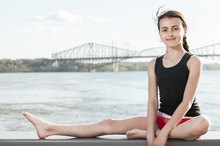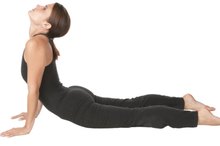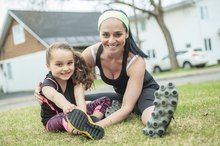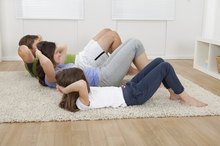What does fact checked mean?
At Healthfully, we strive to deliver objective content that is accurate and up-to-date. Our team periodically reviews articles in order to ensure content quality. The sources cited below consist of evidence from peer-reviewed journals, prominent medical organizations, academic associations, and government data.
The information contained on this site is for informational purposes only, and should not be used as a substitute for the advice of a professional health care provider. Please check with the appropriate physician regarding health questions and concerns. Although we strive to deliver accurate and up-to-date information, no guarantee to that effect is made.
Flexibility Activities for Kids
One reward your child can reap from physical fitness is an increase in her flexibility. According to the American Academy of Pediatrics, children become more agile when they are able to stretch and move their bodies in a full range of motion 1. Encouraging kids to begin stretching in childhood can help them maintain limber physiques throughout life. A variety of physical activities are available for your kid to improve her flexibility.
Classes
Explore local gyms, community colleges or community centers for youth-oriented classes that focus on stretching and flexibility. Options include gymnastics, yoga, dance or martial arts. Before your child enrolls in a program, make sure the class suits your child's fitness and flexibility levels. The American Council on Exercise reminds parents that children going through growth spurts can be vulnerable to injuries as a result of tight or inflexible muscles 2. Know your child's physical limits to help prevent injuries in class.
- Explore local gyms, community colleges or community centers for youth-oriented classes that focus on stretching and flexibility.
Group Games
Posture Exercises for Kids
Learn More
Divide kids into groups of four. Assign each group a letter of the alphabet. Encourage the teammates to increase flexibility by working together to stretch their bodies into an alphabet letter. Kids can either lie down or stand to form a letter; have other kids try to guess the letter. To improve hip and back flexibility, play limbo. Have two people each hold an end of a broomstick at chest height. One at a time, the children should travel under the stick by leaning backward without letting a body part touch the ground or the stick. After each round in which everyone has gone under the broom, lower the broom 2 or 3 inches. The game continues until one child is left.
- Divide kids into groups of four.
- After each round in which everyone has gone under the broom, lower the broom 2 or 3 inches.
Partner Stretches
Stretching together can be effective and enjoyable. Position two children facing each other and encourage one youngster to perform any bodily stretch desired, such as bending at the waist and reaching for the toes. The partner should copy or mirror the stretch. Direct the kids to switch to allow the other partner do a stretch for the other youngster to mirror. For another partner exercise, have one child stand with arms at his side and lift them slightly to the back. Have the partner stand behind and gently pull the front child's wrists toward him to stretch the chest, shoulders and biceps.
- Stretching together can be effective and enjoyable.
- Position two children facing each other and encourage one youngster to perform any bodily stretch desired, such as bending at the waist and reaching for the toes.
Desk Exercises
Exercises to Help Toe Walking Kids
Learn More
To increase flexibility of the shoulders, situate a child at a desk with one arm raised above her head. Instruct the youngster to bend the raised arm at the elbow; reach it down as far as possible and scratch the upper back with the fingers. Perform the exercise with the other arm, too. Improve the range of motion in the wrists by placing the elbows on a desk with fisted hands up in the air. Have your child twist both wrists in an inward circle, or toward the torso. Switch and twist the wrists in an outward circle, or away from the torso.
- To increase flexibility of the shoulders, situate a child at a desk with one arm raised above her head.
- Instruct the youngster to bend the raised arm at the elbow; reach it down as far as possible and scratch the upper back with the fingers.
Related Articles
References
- American Academy of Pediatrics: Promoting Physical Activity as a Way of Life
- American Council on Exercise: Kids in Motion
- "Trim Kids"; Melinda S. Sothern, Ph.D., M.Ed., C.E.P., et al.; 2003
- "Old Favorites, New Fun: Physical Education Activities for Children"; David Oatman; 2007
- "404 Deskside Activities for Energetic Kids"; Barbara Davis, MS, MFA; 2008
- BurningHeart View Profile
- Mtguy8787 View Profile
- LJ57 View Profile
- redhawk76 View Profile
Resources
Writer Bio
Julia Drake has been writing since 2007 when she had her first article published in “The Beltane Papers.” She received her Bachelor of Arts in women studies from the University of Washington. She recently completed her Master of Arts in women’s spirituality at the Institute of Transpersonal Psychology.









